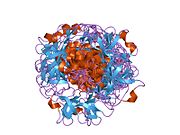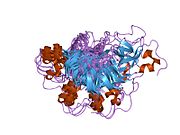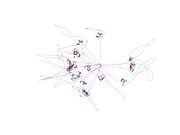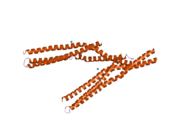BIN1
Myc box-dependent-interacting protein 1, also known as Bridging Integrator-1 and Amphiphysin-2 is a protein that in humans is encoded by the BIN1 gene.[5][6][7]
Clinical significance
In humans, mutations in BIN1 have been associated with skeletal myopathies including centronuclear myopathy causing muscle weakness[7] and myotonic dystrophy causing progressive muscle wasting, myotonia, cataracts, and heart conduction defects.[8] An association has also been found between BIN1 mutations and Alzheimer's disease [8] and with cognitive decline. [9] Knockdown of BIN1 in produces a cardiomyopathy phenotype in zebrafish,[10] and in sheep BIN1 may be responsible for the loss of T-tubules seen in heart failure.[11]
Interactions
BIN1 has been shown to interact with Phospholipase D1,[12] SNX4[13] and PLD2.[12]
References
- ^ a b c GRCh38: Ensembl release 89: ENSG00000136717 – Ensembl, May 2017
- ^ a b c GRCm38: Ensembl release 89: ENSMUSG00000024381 – Ensembl, May 2017
- ^ "Human PubMed Reference:". National Center for Biotechnology Information, U.S. National Library of Medicine.
- ^ "Mouse PubMed Reference:". National Center for Biotechnology Information, U.S. National Library of Medicine.
- ^ Negorev D, Riethman H, Wechsler-Reya R, Sakamuro D, Prendergast GC, Simon D (January 1997). "The Bin1 gene localizes to human chromosome 2q14 by PCR analysis of somatic cell hybrids and fluorescence in situ hybridization". Genomics. 33 (2): 329–31. doi:10.1006/geno.1996.0205. PMID 8725406.
- ^ Sakamuro D, Elliott KJ, Wechsler-Reya R, Prendergast GC (October 1996). "BIN1 is a novel MYC-interacting protein with features of a tumour suppressor". Nat Genet. 14 (1): 69–77. doi:10.1038/ng0996-69. PMID 8782822.
- ^ a b Nicot AS, Toussaint A, Tosch V, Kretz C, Wallgren-Pettersson C, Iwarsson E, Kingston H, Garnier JM, Biancalana V, Oldfors A, Mandel JL, Laporte J (August 2007). "Mutations in amphiphysin 2 (BIN1) disrupt interaction with dynamin 2 and cause autosomal recessive centronuclear myopathy". Nat Genet. 39 (9): 1134–9. doi:10.1038/ng2086. PMID 17676042.
- ^ a b Prokic, Ivana; Cowling, Belinda S.; Laporte, Jocelyn (May 2014). "Amphiphysin 2 (BIN1) in physiology and diseases". Journal of Molecular Medicine (Berlin, Germany). 92 (5): 453–463. doi:10.1007/s00109-014-1138-1. ISSN 1432-1440. PMID 24590001.
- ^ Vivot, A; Glymour, M M; Tzourio, C; Amouyel, P; Chêne, G; Dufouil, C (2015-06-02). "Association of Alzheimer's related genotypes with cognitive decline in multiple domains: results from the Three-City Dijon study". Molecular Psychiatry. 20 (10): 1173–1178. doi:10.1038/mp.2015.62. ISSN 1359-4184.
- ^ Hong, Ting-Ting; Smyth, James W.; Chu, Kevin Y.; Vogan, Jacob M.; Fong, Tina S.; Jensen, Brian C.; Fang, Kun; Halushka, Marc K.; Russell, Stuart D. (May 2012). "BIN1 is reduced and Cav1.2 trafficking is impaired in human failing cardiomyocytes". Heart Rhythm. 9 (5): 812–820. doi:10.1016/j.hrthm.2011.11.055. ISSN 1556-3871. PMC 3306544. PMID 22138472.
- ^ Caldwell, Jessica L.; Smith, Charlotte E. R.; Taylor, Rebecca F.; Kitmitto, Ashraf; Eisner, David A.; Dibb, Katharine M.; Trafford, Andrew W. (2014-12-05). "Dependence of cardiac transverse tubules on the BAR domain protein amphiphysin II (BIN-1)". Circulation Research. 115 (12): 986–996. doi:10.1161/CIRCRESAHA.116.303448. ISSN 1524-4571. PMC 4274343. PMID 25332206.
- ^ a b Lee, C; Kim S R; Chung J K; Frohman M A; Kilimann M W; Rhee S G (June 2000). "Inhibition of phospholipase D by amphiphysins". J. Biol. Chem. 275 (25). UNITED STATES: 18751–8. doi:10.1074/jbc.M001695200. ISSN 0021-9258. PMID 10764771.
{{cite journal}}: Cite has empty unknown parameters:|laydate=,|laysource=, and|laysummary=(help)CS1 maint: unflagged free DOI (link) - ^ Leprince, Corinne; Le Scolan Erwan; Meunier Brigitte; Fraisier Vincent; Brandon Nathalie; De Gunzburg Jean; Camonis Jacques (May 2003). "Sorting nexin 4 and amphiphysin 2, a new partnership between endocytosis and intracellular trafficking". J. Cell Sci. 116 (Pt 10). England: 1937–48. doi:10.1242/jcs.00403. ISSN 0021-9533. PMID 12668730.
{{cite journal}}: Cite has empty unknown parameters:|laydate=,|laysource=, and|laysummary=(help)
Further reading
External links
- Human BIN1 genome location and BIN1 gene details page in the UCSC Genome Browser.













